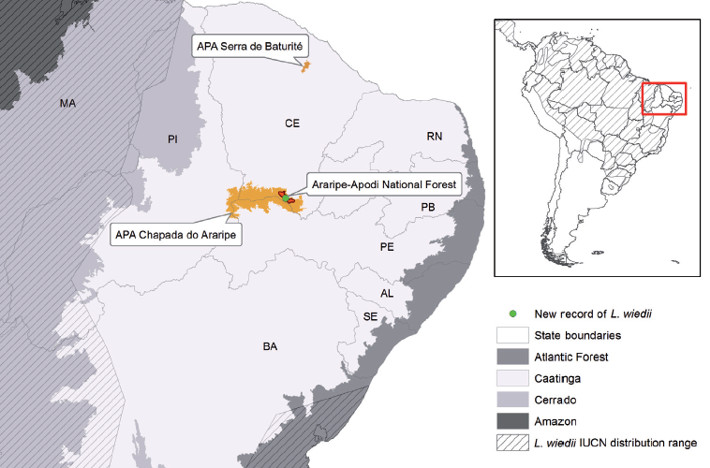A new record of margay Leopardus wiedii (Schinz, 1821) in the Brazilian Caatinga domain
DOI:
https://doi.org/10.31687/SaremNMS24.03.8Keywords:
mammals, semi-arid, small neotropical felids, threatened species, tropical dry forestAbstract
The margay is a small neotropical wild felid, typical of forested environments, with high arboreal skills. Near threatened worldwide, this species is considered Vulnerable in Brazil. We report a new record of Leopardus wiedii in the semi-arid Brazilian Caatinga domain, outside its known distribution area and approximately 350 km from the nearest known record for the species. The animal arrived in the Araripe-Apodi National Forest in 2015, after being handed over to the environmental police by local residents. Future research should investigate the ecology and population status of L. wiedii in this region to support efficient conservation strategies.
References
Albuquerque, U. P., et al. 2012. Caatinga revisited: ecology and conservation of an important seasonal dry forest. The Scientific World Journal 2012:1–18. https://doi.org/10.1100/2012/205182.
Emmons, L. H., & F. Feer. 1997. Neotropical rainforest mammals. A field guide. The University of Chicago Press, Chicago.
Espinosa, C. C., et al. 2018. Geographic distribution modeling of the margay (Leopardus wiedii) and jaguarundi (Puma yagouaroundi): a comparative assessment. Journal of Mammalogy 99:252–262. https://doi.org/10.1093/jmammal/gyx152.
Feijó, A., & A. Langguth. 2013. Mamíferos de médio e grande porte do Nordeste do Brasil: distribuição e taxonomia, com descrição de novas espécies. Revista Nordestina de Biologia 22:1–225.
Fernandes-Ferreira, H., N. M. Gurgel-Filho, A. Feijó, S. V. Mendonça, R. R. N. Alves, & A. Langguth. 2015. Non-volant mammals from Baturité Ridge, Ceará state, Northeast Brazil. Checklist 11:1630. https://doi.org/10.15560/11.3.1630.
ICMBIO (Instituto Chico Mendes de Conservação da Biodiversidade). 2022. Portaria ICMBIO Nº 493, de 21 de junho de 2022. 2º ciclo do Plano de Ação Nacional para a Conservação dos Pequenos Felinos – PAN Pequenos Felinos. <https://www.gov.br/icmbio/pt-br/assuntos/biodiversidade/pan/pan-pequenos-felinos/2-ciclo/pan-pequenos-felinos-portaria-aprovacao.pdf>.
Meira, L. P. C., A. R. Pereira, J. M. Ministro, D. M. Santos, E. C. Aroucha, & T. G. DE Oliveira. 2018. First records and abundance of margay Leopardus wiedii from semi-arid thorny scrub habitat of the Brazilian Caatinga. Revista Mexicana de Biodiversidad 89:321–326. https://doi.org/10.22201/ib.20078706e.2018.1.1940.
MMA (Ministério do Meio Ambiente). 2022. Portaria MMA Nº 148, de 7 de junho de 2022. Atualização da Lista Nacional de Espécies Ameaçadas de Extinção. <http://in.gov.br/en/web/dou/-/portaria-mma-n-148-de-7-de-junho-de-2022-406272733>.
Moro, M. F., M. B. Macedo, M. M. D. Moura-Fé, A. S. F. Castro, & R. C. D. Costa. 2015. Vegetação, unidades fitoecológicas e diversidade paisagística do estado do Ceará. Rodriguésia 66:717–743. https://doi.org/10.1590/2175-7860201566305.
Nascimento, F. O., & A. Feijó. 2017. Taxonomic revision of the tigrina (Schreber, 1775) species group (Carnivora, Felidae). Papéis Avulsos de Zoologia 57:1–34. https://doi.org/10.11606/0031-1049.2017.57.19.
Novaes, R. L. M, & R. S. Laurindo. 2014. Morcegos da Chapada do Araripe, Nordeste do Brasil. Papéis Avulsos de Zoologia 54:315–328. https://doi.org/10.1590/0031-1049.2014.54.22.
Olifiers, N., & A. C. Delciellos. 2013. New record of Lycalopex vetulus (Carnivora, Canidae) in Northeastern Brazil. Oecologia Australis 17:533–537. https://doi.org/10.4257/oeco.2013.1704.08.
Oliveira, T. de, A. Paviolo, J. Schipper, R. Bianchi, E. Payan, & S. V. Carvajal. 2015. Leopardus wiedii. The IUCN Red List of Threatened Species 2015:e.T11511A50654216. https://doi.org/10.2305/IUCN.UK.2015-4.RLTS.T11511A50654216.en.
Oliveira, T. G. de. 1988. Leopardus wiedii. Mammalian Species 579:1–6. https://doi.org/10.2307/3504400.
Sema (Secretaria do Meio Ambiente e Mudança do Clima do Ceará). 2022. Lista Vermelha de espécies ameaçadas da fauna do Ceará. <https://www.sema.ce.gov.br/lista-vermelha-de-especies-ameacadas-da-fauna-do-ceara/>.
Silva Neto, B. C., A. L. B. Nascimento, N. Schiel, R. R. N. Alves, A. Souto, & U. P. Albuquerque. 2017. Assessment of the hunting of mammals using local ecological knowledge: an example from the Brazilian semiarid region. Environment, Development and Sustainability 19:1795–1813. https://doi.org/10.1007/s10668-016-9827-2.
Tortato, M. A., T. G. de Oliveira, L. B. Almeida, & B. M. Beisiegel. 2013. Avaliação do risco de extinção do Gato-maracajá Leopardus wiedii (Schinz, 1821) no Brasil. Biodiversidade Brasileira 3:76–83.

Downloads
Published
How to Cite
Issue
Section
License
Copyright (c) 2024 Paulo H. D. Marinho, Patrícia F. Rosas-Ribeiro, Hugo Fernandes-Ferreira, Tadeu G. de Oliveira

This work is licensed under a Creative Commons Attribution-NonCommercial 4.0 International License.

